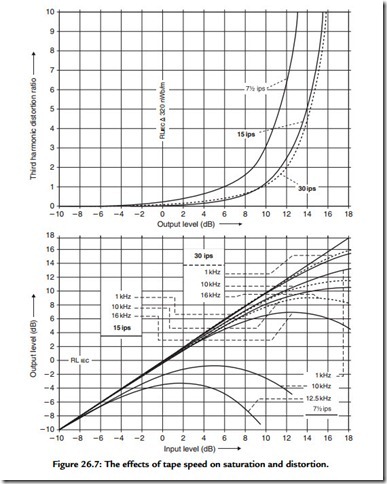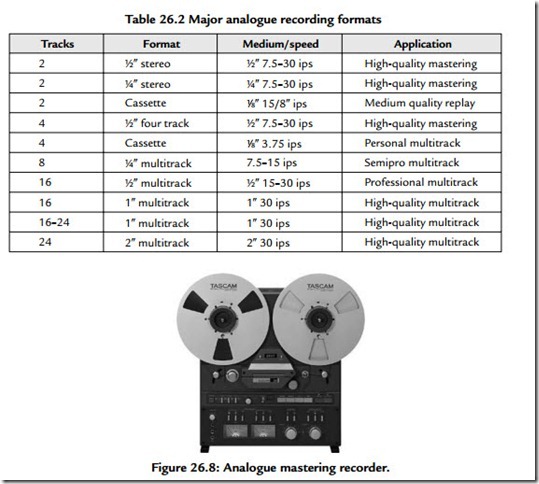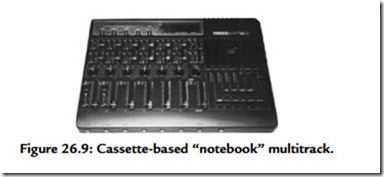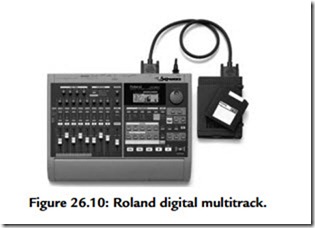Recording Formats—Analogue Machines
Early tape recorders recorded a single channel of audio across the whole tape width. Pressure to decrease expensive tape usage led to the development of the concept of using “both sides” of a tape by recording the signal across half the tape width and subsequently flipping over the tape to record the remaining unrecorded half in the opposite direction. The advent of stereo increased the total number of audio tracks to four: two in one direction, two in the other.
This format is standard in the familiar analogue cassette. From stereo it is a small conceptual step (albeit a very large practical one) to 4, 8, 16, or more tracks being recorded across the width of a single tape. Such a development demanded various technological innovations, the first was the development of composite multiple head assemblies. Figure 26.6 illustrates the general principle. Given the dimensions, the construction of high-quality head assemblies was no mean achievement. The second was the combination of record and replay heads. Without this development, the signal “coming off” tape would be later than the signal recorded onto the tape, a limitation that would make multitrack recording impossible. In early machines, the record head was often made to do temporary duty as playback head during the recording stages of a multitrack session, with its less than perfect response characteristic being adequate as a cue track. The optimized playback head was reserved for mix down only.
Despite this, the number of tracks that it is practical to record across a given width of tape is not governed by head construction limitations only, but by considerations of the signal-to- noise ratio. As shown earlier, the signal recorded onto tape is left as a physical arrangement of magnetic domains. Without an audio signal, these domains remain unmagnetized and persist in a random state. These cause noise when the tape is replayed. Similarly, at some point, when a strong signal is recorded, all the domains are “used up” and the tape saturates. A simple rule applies in audio applications: the more domains onto which the signal is imprinted, the better, up to the point just below saturation. This may be achieved in various ways: by running the tape faster and by using a greater tape width for a given number of tracks. Figure 26.7 illustrates this by depicting the saturation levels of a commercial tape at
various speeds. This simple principle accounts for the many different tape formats that exist. Each is an attempt to redefine the balance among complexity, sound quality, and tape cost appropriate to a certain market sector. Table 26.2 lists some of the major analogue recording formats. Note that the format of a tape relates to its width, specified in inches.
Analogue Mastering
Analogue mastering is now very rare, this office having been made the exclusive domain of digital audio tape. A typical high-quality two-track mastering recorder is illustrated in Figure 26.8.
Analogue Multitrack Tape Machines
As mentioned earlier, analogue multitrack machines betray their quality roughly in proportion to the width of the tape utilized for a given number of tracks. A 2-inch tape, 24 track, which utilizes a 2-inch width tape drawn across 24 parallel heads, is therefore better than a 1-inch, 24 track, but not necessarily better than a ½-inch, two track! Not only does a greater head-to-tape contact guarantee a higher tape signal-to-noise ratio (i.e., more domains are usefully magnetized) but it also secures less tape dropout. Dropout is an effect where the contact between tape and head is broken microscopically for a small period during which the signal level falls drastically. Sometimes dropout is due to irregularities in the tape or to the ingress of a tiny particle of dust; whichever, the more tape passing by an individual recording or replay head, the better chance there is of dropouts occurring infrequently. Analogue tape machines are gradually becoming obsolete in multitrack sound recording; however, the huge installed base of these machines means they will be a part of sound recording for many years to come.
Cassette-Based Multitracks
Figure 26.9 illustrates a typical analogue cassette-based portable multitrack recorder and mixer combined. This type of low-end “recording studio in a box” is often termed a Portastudio and these units are widespread as personal recording “notebooks.” Typically four tracks are available and are recorded across the entire width of the cassette tape (which is intended to be recorded in one direction only). The cassette tape usually runs at twice normal speed, 3.75 ips. Individual products vary but the mixer of the unit illustrated in Figure 26.9 allows for two (unbalanced) microphone inputs and a further four inputs at line level, of which only two are routed to the tape tracks. Each of the first four inputs may be switched between INPUT, OFF, and TAPE (return). Selecting INPUT will (when
the record button is engaged on the tape transport buttons) switch the track to record. The mixer also incorporates two send–return loops and the extra line level inputs mentioned earlier. In addition, an extra monitor mixer is provided, the output of this being selectable via the monitor output. It is thus a tiny split multitrack console. Despite the inevitable compromises inherent in such a piece of equipment, many portable multitrack units are capable of remarkably high quality and many have been used to record and mix release- quality material. Indeed, so popular has this format proved to be that digital versions have begun to appear, products that offer musical notebook convenience with exemplary sound quality. One such is illustrated in Figure 26.10.



